BOGOTÁ - In Colombia, you soon learn that things aren’t always as they appear. Yes, in the land of magic realism you quickly discover that your perception of things differs significantly from reality.
The capital city, Bogotá, is located at high altitude in the Andean mountains so I thought it might resemble Quito, Ecuador, another Andean capital city I had visited. But I was wrong.
Bogotá is full of highly motivated inhabitants, continually on some purposeful errand. And be it by rapid transit, bus, foot, car or bicycle, people are always on the move. This city is also known worldwide for closing down its main thoroughfares on Sundays so that cyclists can take over.
Keeping an eye on the residents of this bustling capital is the omnipresent Policía Nacional.
To gain some perspective on the ever-present police, I visited their National Police Museum, just a hop, skip and jump from the main square, the Plaza Bolívar.
The armed, Colombian-wide police force appear unapproachable from a distance. However, just as playfulness often lurks under the macho exterior of Latin America, at the National Police Museum the mostly young agents (both male and female) were more than willing to talk freely about Colombia’s past problems. One police guide was dressed for undercover work in a monk’s white cassock, although he assured us he wore his police uniform underneath.
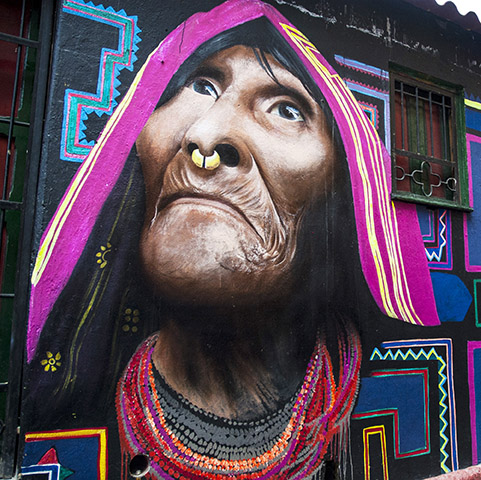
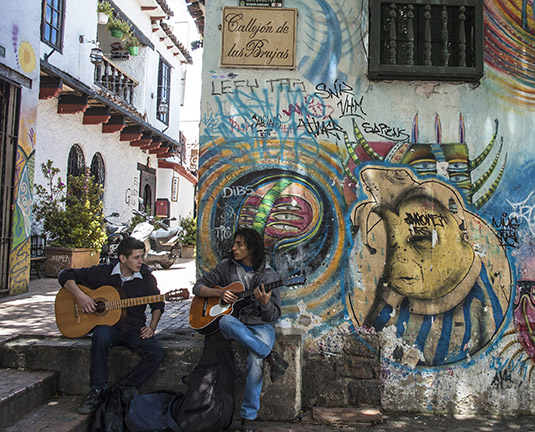
Left: Dramatic wall murals like this make Bogota an outdoor art gallery. Right: In the heart of Le Candelaria, music and art make up the street scene.
No topic is taboo, including the notorious Pablo Escobar. Once on the list of the richest men in the world, Escobar controlled one of Colombia’s drug cartels with an iron fist. At the museum you can view his peach-coloured Harley-Davidson and some of his possessions, including cassette tapes, a VCR, a watch and a pair of eyeglasses. His operations ended in 1993 when he died in a shootout with police.
Another subtle, yet at the same time striking, example of things not being quite as they appear, are the wall paintings and graffiti of Bogotá. The casual observer might mistake the city’s street art for visual pollution. But a closer look reveals a landscape of artwork by local and foreign grafiteros (graffiti artists) who have made Bogotá their cultural centre. So much so, that local art tours explain the styles and backgrounds of over 10 artists whose work becomes easily identifiable.
Want to see where some of the planet’s top graffiti artists are doing their thing? Head for Bogotá’s Le Candelaria neighbourhood, which is within walking distance of the Plaza Bolívar and the Police Museum. If you take the guided tour, you’ll see the difference between graffiti art and mere tagging.
No one seems to like the taggers, whose unfortunate work makes up 80 per cent of the street art here. But the other 20 per cent creates what is now being hailed as cutting-edge contemporary art.
In Le Candelaria district — Bogotá’s oldest area — artists and their work can be viewed. Some have been at it for 30 years, such as Rodez, who is also an illustrator, and his sons Nomada and Malaguia. Rodez’ bold work is characterized by ferocious eyes, or, sometimes, no eyes at all.
Businesses here can find themselves in a tricky situation; they can wait to be tagged against their will, or submit to graffiti art; neither is illegal in Colombia. Some businesses will resign themselves to the will of grafiteros while others, like the Café Rosas, will actively seek out artists.
Some grafiteros, like Guache (a photographer and anthropologist), end up being commissioned and sponsored by Montana 24, one of the world’s high-end spray paint companies.
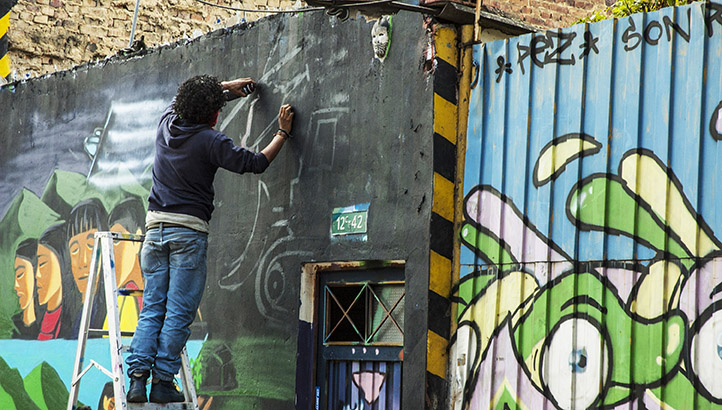
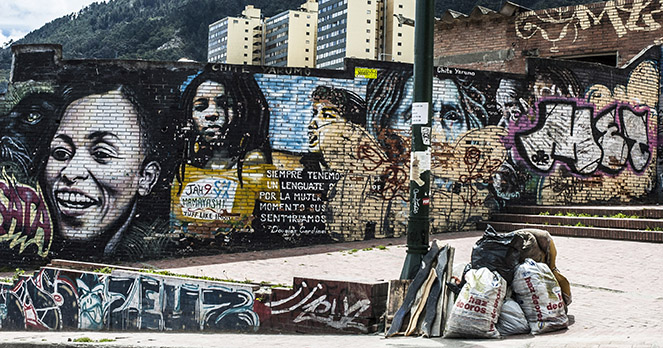
Left: Wall painters keep adding to their collections. Right: Daily life in the Colombian capital is played out on its walls.
Grafiteros like Ronzo prefer subtle styles but some, like Pez (originally from Barcelona), is known for his happy style. He has designed shoes, T-shirts, even shower curtains.
Graffiti is taken so seriously here that at the Plaza de Mercado La Concordia there is a school program to teach the art to schoolchildren. The huge walls that surround the plaza provide canvases for practice and are painted over and over again. We saw a partial quotation from Canadian Douglas Cardinal (an indigenous architect) on one wall and two walls on either side of the nearby market featured copies of work by Mexican artist Diego Rivera.
The artwork in the area is strikingly original.
Some of the oldest streets and plazas in Bogotá are decorated by grafiteros. Historically, the Casa Locombia, the local circus school, started the trend by having their exterior walls and their transport van painted by a grafiteros. The Casa Bella Vista Hostel, located in the ancient street of Callejón del Embudo, invited well-known Australian graffiti artist Crisp to illustrate the walls of the many hostels in the area.
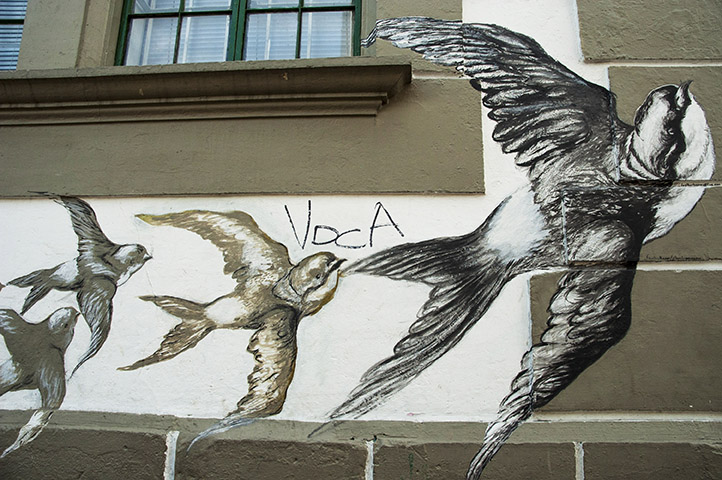
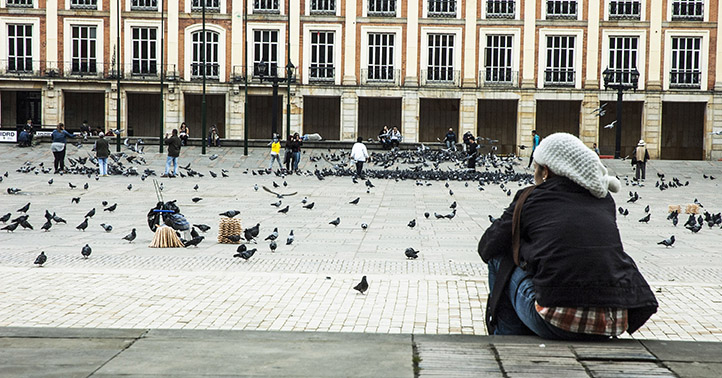
Left: Wall murals come in many forms on the streets of Bogota. Right: Public spaces like this make Bogota one of the most beautiful cities in Latin America.
It’s an odd, narrow street, blarin’ with music, with vendors of all kinds and tattoo artists plying their trade. You can sample coca tea here — great for those suffering from the city’s high altitude, cool temperatures and endlessly threatening rain. Or just try it for the sake of trying it. You will see almost as many foreigners as Colombians here with backpackers of all ages crammed into the hundreds of small hostels, almost like the gringo trail of the 1970s.
It’s the kind of place where on weekends (which begin on Thursdays, by the way), live music and bars start early and operate into the wee hours.
Depending on the time of day you go, you might easily run into a graphic artist starting or finishing up a job.
Soon after our tour, we sampled the coca tea. No reaction, I’m sorry to report. Then, in spite of being warned, I chomped into a tiny green lime-like fruit whose interior was a bright orange. It was another example of things not being exactly as they appear. Boy was that lime ever sour!
Information
Although the graffiti tour’s admission is by donation, your presence should be booked beforehand at www.bogotagraffiti.com / The National Police Museum’s hours are 8 am to 5 pm, every day except Monday. No admission charge. / From Eastern Canada, both Copa Airlines and Air Canada fly to Bogotá.
About the Author
While still a teenager, Bruce Sach's travelling career started off badly. After being dragged by well-meaning parents onto a plane, he reluctantly took his seat only to have a flight attendant drop a bowl of salad on his head. He realized he should have stayed home. Years later, home (Edmonton) had shifted to Ottawa and he came to the conclusion that travel was an okay thing to do. Countless airplane meals and salad bowls later, Bruce is equally at ease in an Indonesian phinsi or viewing calving Greenlandic icebergs, and is able to adapt to most any locale. Every new destination increases his interest in visiting and reporting.